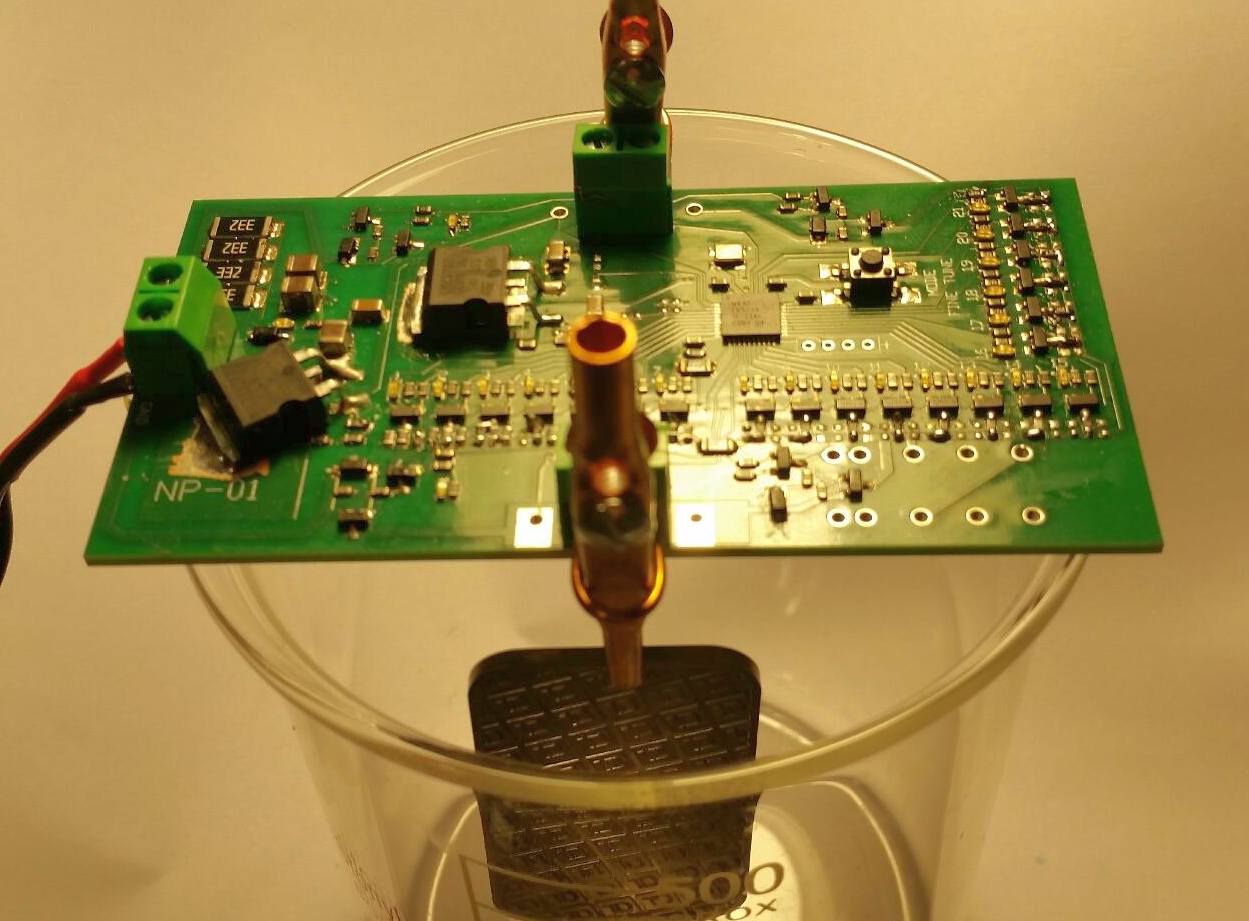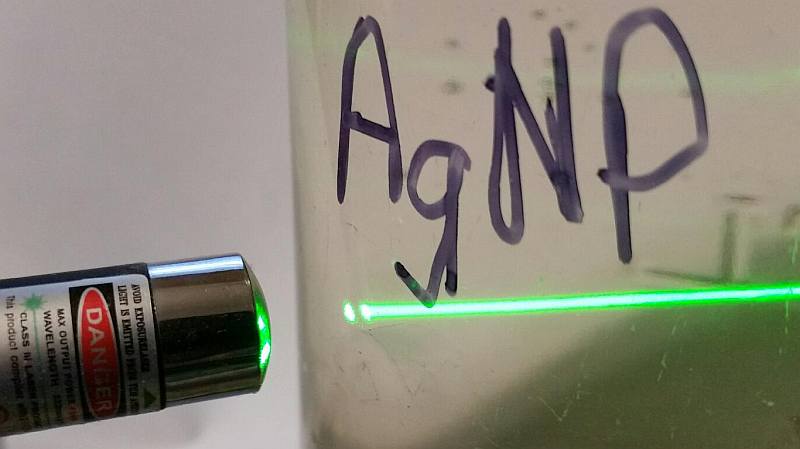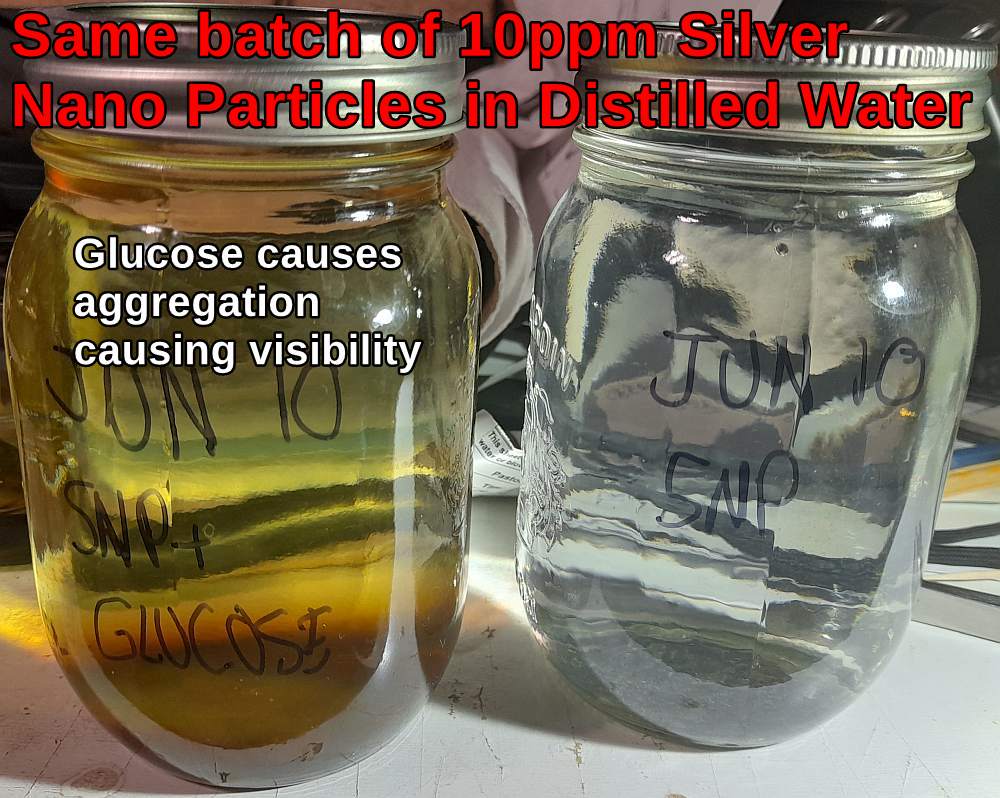
 Nestronics
Nestronics

 Nestronics
Nestronics
For AgNP generation you need to be aware that both Ag+ and AgNPs are produced. Most people want AgNPs, and not Ag+,
as Ag+ is typically considered more toxic. There is a equilibrium in the solution between these two.
1. TDS (total dissolved solids) meters only measure conductivity. Which is this case is based on mixed ionic species from water electrolysis.
Of which only some of the ions are Ag+. AgNPs (silver nanoparticles) do not affect the conductivity. So a measurement using
a TDS meter only reflects a relative amount of Ag+, and is not directly ties to AgNPs ppm at all.
2. Color of the water maybe be some indication of the size of the AgNPs. (see below)
3. In Colorless solution, Laser Pointers may be used to help judge the size of the AgNPs.
- green laser pointer producing a fine hazy line in colorless solution may indicate 1-8nm sizes.
- violet lazer pointer producing a fine hazy line in colorless solution may indicate 1-3nm sizes.
4. A laser pointer does not produce a visible line from ionic Ag+ ions.
5. placing a few mL of AgNP solution in a test tube and adding a drop of saturated salt water, will turn cloudly almost
immediately in the presences of ionic Ag+, but not AgNPs. Hence this test may be used as rough indication of the presence
of Ag+.
6. Placing copper in the AgNP solution also causes Ag+ to be plated onto the copper, releasing Cu2+ ions into the solution
in exchange. This can also be used at a test for Ag+ but a time limit (30secs?) must be assigned becuase as the Ag+ drops more
will be produced from the solution because of the tiny amounts of oxygen in the solution. Also the plating may not be
visible unless wiped off with filter paper.
7. Over time as oxygen is introduced into the AgNP solution the amount of Ag+ increase.
Note this AgNP generator is designed for research purposes.
It presences a possible shock hazard as the electrodes are exposed from top. Use at your own risk.
The PCB (printed circuit board) is designed to sit on top of a beaker (250ml beaker)
with 2 standard 1 oz silver bars suspended by alligator clips. It is powered from
a 56V power supply. I placed the beaker on a magnetic stirrer set to 250rpm.
The stirrer helps to keep the particle size smaller.

Small silver nano particles (less than 10nm) cause refraction of light in water with a laser pointer.

The smaller the silver nano particles the less visible they appear to the naked eye. Size vs Color Chart 2nm : colorless 5-10nm : yellow 20-40nm : Dark yellow to orange 50-80nm : Reddish-orange to Brown >100nm : Grey, blue, or cloudy The picture below demonstates the effect. The addition of a few drops of glucose causes the aggregation of nanoparticles causing them to become visible. Time will also cause aggregation to larger particles, as will light exposure.

Silver Nano Particles have been used for medicinal purposes, including for cancer research.
Research from database on Silver NanoParticles and Cancer
Some of the above research includes Silver NanoParticles(SNP) combined with Magnetic Fields (MF)
The Generators are commonly available from many sources, but I have chosen to design one.
As I like to understand how they work, so I know the smallest possible nano particle size is being acheived.
Features:
1. Uses commonly available 1oz silver bars for electrodes. Note that silver bars may have a anti-tarish coating that
must be removed.
-ensures a large electrode surface for the electrodes.
-ensures high purity for low contamination.
-long lasting
2. Targets smallest possible nano particles for increased efficacy./825=
- less than 1mA of current per sq inch of electrode space helps ensure smallest possible particle size but...
- larger current up to 1mA/cm2 can also help reduce AgNP size (must be balanced)
- plus a large spacing between the electrodes.
- mixing with magnetic stirrer at 250 rpm.
3. Target for higher AgNPs (Ag0) vs ionic silver (Ag+).
- higher current helps reduce Ag+ relative to Ag0.
4. Automatic
-The MCU controlled unit, automatically monitors the current, and adjusts to keep it under 2mA (for 2 sq in of electrode area)
-The unit automatically turns off when the desired ppm is reached.
5. Tailored for lower ppm
- lower ppm means smaller particles, and longer lasting solution.
- the resulting water should be entirely clear.
- a laser pointer(s) (green and violet) thru the water, shows a very fine fuzzy line, indicating small particles.
6. 56V power supply.
-high voltage power supply means faster startup, as distilled water has low conductivity.
I used the PSAC30U-560L6 power supply from Digikey.
Download the cpp code for the Silver Nano Particle Generator.
firmware download link
Download the Gerber files(in a zip file) for getting the PCB made (recommend PCBWAY).
All the information you need for ordering is in the readme.txt file.
Also remember to order the solderscreen (without frame) so you can use a razor blade (or other tool)
to squeegee the solderpaste on to the board.
Gerber file download link
Parts list and placement is in a PDF file. Most of the surface mount chip components are 0603 size so
they are fairly easy to manually place with a vacuum tool.
Parts Placement file (optimized for 2mA current) download link
The only documention missing is a schematic, which I hope to eventually draw and put up.
But you don't really need the schematic to build the unit, and it is a simple cct that can
be easily followed from the PCB. Basically the MCU controls the polarity reversal MOSFETs
(which software alternates every 4 minutes),
then the 21 MOSFETs for selecting the amount of current draw. There is a current sense resistor (100 ohm)
that is used by the MCU to determine when to switch the MOSFETs.
A power up sequence for the MCU verifies the LEDs are all working,
as this also helps troubleshoot the board. After the sequence the MCU displays the LED setting that it
is set to (one of 21 settings). This is displayed for 10 seconds. During this 10 second interval you
may use the switch on the board to change the setting. When done with the selection, after a 10 second time
out the selection will be saved(for the next powerup), and the silver nano particle generation will start, starting at the lowest setting (#1).
It will sequence thru then turn off when your desired selection is completed.
I typically use setting 21 and it runs for about 90 mins, producing about 10ppm on a TDS meter. But this will vary,
as I noticed a conditioning time for the silver, likely becuase of the anti-tarish coating. So you will want to try to
remove the anti-tarish coating as it may also contaminate the solution.
I recommend sanding them. It may be best to pick one side(front side) and sand it smooth to remove the raised lettering(embossing).
If the back side has extensive debossing, I would recommend you always install the bars with front sides facing each other in the generator.
The back side of the bars (electrodes) seem to see little electrolytic action so they are less critical to remove the anti-tarish coating.
Also it is important to use good distilled water.
If you do not have good distilled water the setting #1 will likely not run for very long before switching to #2 and so forth.
More importantly you need good distilled water to avoid any undesired electrolytic reaction that will contaminate the batch.
Typically setting 1 is the longest running time if the distilled water is good. (low TDS meaning low conductivity)